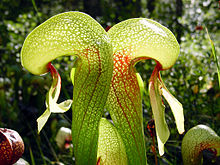Darlingtonia (Sarraceniaceae)
| Cobra lily | |
|---|---|
 |
|
| Darlingtonia's translucent leaves confuse insects trying to escape | |
| Scientific classification | |
| Kingdom: | Plantae |
| (unranked): | Angiosperms |
| (unranked): | Eudicots |
| (unranked): | Asterids |
| Order: | Ericales |
| Family: | Sarraceniaceae |
| Genus: | Darlingtonia |
| Species: | D. californica |
| Binomial name | |
|
Darlingtonia californica Torr. (1853) |
|
 |
|
| Darlingtonia distribution | |
| Synonyms | |
|
|
Darlingtonia californica /dɑːrlɪŋˈtoʊniə kælᵻˈfɔːrnᵻkə/, also called the California pitcher plant, cobra lily, or cobra plant, is a species of carnivorous plant, the sole member of the genus Darlingtonia in the family Sarraceniaceae. It is native to Northern California and Oregon, growing in bogs and seeps with cold running water. This plant is designated as uncommon due to its rarity in the field.
The name "cobra lily" stems from the resemblance of its tubular leaves to a rearing cobra, complete with a forked leaf - ranging from yellow to purplish-green - that resemble fangs or a serpent's tongue.
The plant was discovered in 1841 by the botanist William D. Brackenridge at Mount Shasta. In 1853 it was described by John Torrey, who named the genus Darlingtonia after the Philadelphian botanist William Darlington (1782–1863).
The cobra plant is not only restricted to nutrient-poor acidic bogs and seepage slopes, but many colonies actually thrive in ultramafic soils, which are in fact basic soils, within its range. In common with most carnivorous plants, the cobra lily is adapted to supplementing its nitrogen requirements through carnivory, which helps to compensate for the lack of available nitrogen in such habitats.
...
Wikipedia

